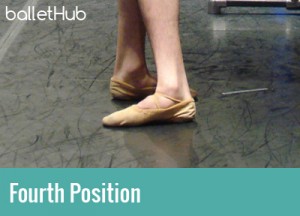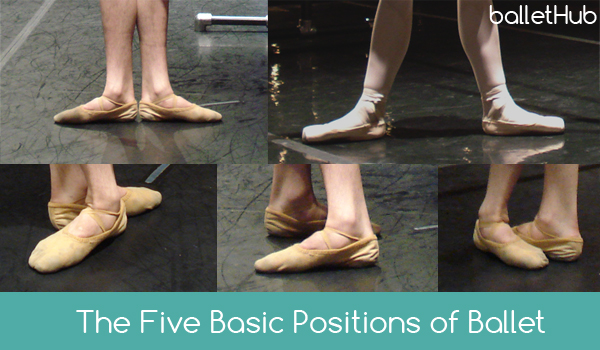In classical ballet, there are five basic positions of both the feet and arms. First, we’ll take a look at the five basic ballet positions of the feet. The five basic positions are usually one of the first things taught in a beginner’s ballet class but are essential to the technique of classical ballet as practically every step begins and ends in one of the five basic positions.
What are the Five Basic Positions of Ballet?
The positions of the feet include first position, second position, third position, fourth position and fifth position. There are also other basic ballet positions of the arms that can be combined with other beginner and advanced steps. When a teacher asks “Start in First Position…” they are generally referring to the feet.
First Position
 Possibly the easiest of the basic ballet positions is first position in ballet is a position of the feet where a dancer is standing with their heels together and toes facing equally out to either side. For a beginner, its best just to think of the heels as needing to touch, but for more advanced dancers, no more than 2 inches should be between the heels. Unless in a plié, the legs are straight. The feet and legs should also be equally turned out.
Possibly the easiest of the basic ballet positions is first position in ballet is a position of the feet where a dancer is standing with their heels together and toes facing equally out to either side. For a beginner, its best just to think of the heels as needing to touch, but for more advanced dancers, no more than 2 inches should be between the heels. Unless in a plié, the legs are straight. The feet and legs should also be equally turned out.
Read more about first position of the feet.
Second Position
 Continuing with our ballet positions, we come to second position which is very similar to first, just with the feet about hip distance apart. The same ideas as first position are true for second, where you want to have the feet and legs equally turned out. Its important not to have your second position too wide that its not useful, or too narrow that it looks closer to a first position.
Continuing with our ballet positions, we come to second position which is very similar to first, just with the feet about hip distance apart. The same ideas as first position are true for second, where you want to have the feet and legs equally turned out. Its important not to have your second position too wide that its not useful, or too narrow that it looks closer to a first position.
Third Position
 Third position is very rarely done, though it still has a spot as one of the five basic ballet positions. The reason it is not commonly used beyond a beginner level is that a third position can very easily look like a misplaced first or fifth position. To do third position, simply start in first position, then move the heel of one of your feet to the middle of the other. Your legs should remain straight with the feet and legs turned out equally.
Third position is very rarely done, though it still has a spot as one of the five basic ballet positions. The reason it is not commonly used beyond a beginner level is that a third position can very easily look like a misplaced first or fifth position. To do third position, simply start in first position, then move the heel of one of your feet to the middle of the other. Your legs should remain straight with the feet and legs turned out equally.
Fourth Position
 Fourth position is a very important position for different types of pirouettes. To stand in fourth position, place one foot in front of the other, about a foot’s distance apart. By now, you can also guess that the legs and feet should be equally turned out away from the center of the body. Like second position, its important to remember not to have too wide of a fourth position that its not useful, or too narrow that it is confused with a “wide” fifth position. There are different thoughts on how crossed your feet should be, but you can never go wrong with lining the heel of the front foot with the toes of the back.
Fourth position is a very important position for different types of pirouettes. To stand in fourth position, place one foot in front of the other, about a foot’s distance apart. By now, you can also guess that the legs and feet should be equally turned out away from the center of the body. Like second position, its important to remember not to have too wide of a fourth position that its not useful, or too narrow that it is confused with a “wide” fifth position. There are different thoughts on how crossed your feet should be, but you can never go wrong with lining the heel of the front foot with the toes of the back.
Fifth Position
 The most difficult of all the basic ballet positions is fifth position. To do fifth position in ballet, stand with your feet close together, one in front of the other and turned out away from the body. The real difficulty of fifth position is maintaining straight legs and proper turnout, then being able to use this position to do jumps and turns.
The most difficult of all the basic ballet positions is fifth position. To do fifth position in ballet, stand with your feet close together, one in front of the other and turned out away from the body. The real difficulty of fifth position is maintaining straight legs and proper turnout, then being able to use this position to do jumps and turns.
Tips for the Five Basic Ballet Positions
While possibly learned in your first few ballet classes, the five basic ballet positions are used countless times in classes and on stage. They are considered basic, but very difficult to master, even for seasoned professionals. Here are a few tips for the five basic ballet positions:
- Try to keep equal turn out with your legs and feet.
- Your turnout doesn’t need to be “perfect.” Its more important that you can stand safely and confidently in each position so you can use them for more difficult steps.
- Try to keep both of your feet evenly flat on the floor. You shouldn’t be rolling your feet or ankles to standing in a basic ballet position.
- Unless you’re in a plie, try to think of your legs squeezing together and down into the floor so you can pull up with your upper body.
- For advanced students, your legs should be straight in every position. If you can’t get them straight, try lessening your turnout a little. Always work with straight legs first, then into your turnout.
The Five Basic Ballet Positions of the Arms
Now that we have the feet covered, let’s continue on to the arms. The position of your arms are just as important as your feet, no matter whether you’re a beginner ballet student, an advanced student, or a seasoned professional! While there are several different positions of the arms possible in classical ballet, this post will cover just the basic positions of the arms.
Before we begin, it is good to know that the positions of the feet aren’t necessarily always done with the same position of the arms. For example, just because you are standing in a fifth position, doesn’t mean your arms will always also be a in fifth… the teacher or choreographer may have asked for them to be in first! Let’s take a look at the five basic ballet positions of the arms.
First Position of the Arms
First position with the arms looks like you are holding a beach ball in the middle of your stomach right in front of you. The fingers do not touch, but have the tips pointing towards each other about 4 inches apart. Your hand should be slightly tilted so the inside of your hand is facing towards your face. A good way to imagine and work on this slight tilt of the hands is to imagine holding a mirror; if your hand is tilted right, you’d be able to look down and see your face reflecting back at you!
Your elbows should be lifted so they are held higher than your hands. A well placed first position should not have the arms parallel with the floor, but angled down slightly so the hands are in the middle of your torso.
Second Position of the Arms
Second position of the arms in ballet, much like second position with the feet, looks very much like first, but open. To try second position, start in a nice looking first position of the arms, then open at the elbows, only moving them slightly back a couple inches. Keep the same shape of the entire arm, so that your elbows are higher than your hands with your hands ever so slightly tilted upwards.
The key to a great second position is to remember to keep your hands below your elbows and not open them too wide. A proper second position is placed just slightly in front of your body, not directly side. For a nice looking second position of the arms in ballet, you’ll also want to try to keep them slightly rounded; not quite as rounded as first, but still rounded so you’re making a slightly curved shape.
Third Position of the Arms
Unlike third position of the feet, third position of the arms is actually used quite a lot in ballet. Unlike first and second, third position can be done with alternating arms. Start with your arms in first, and simply open one arm to second, leaving the other one in its place in first. That’s third position! You can think of it as a combination of first and second.
All of the same rules apply still, so remember to try to keep your hands below your elbows with a slight tilt of the hands in third position.
Fourth Position of the Arms
Next on our list of basic ballet positions is fourth. Fourth will start to be a little trickier than the first three positions. Starting in first position of the arms, move to a third position by opening one arm. Now, with the arm still in first, lift it above your head, completing the fourth position. Since you already know how to hold your arm in second, let’s focus on the one you just lifted above.
Like all other ballet positions of the arms, you want to make sure the arms are curved so it looks like you have no elbows, not too straight and not too bent so your elbows look pointy. Also, the same tip of the hands applies when your arm is lifted up; you want to have the inside of your hand facing towards your face so that if you titled your head slightly upwards, you’d see your reflection if you were holding a mirror. Try to keep your arms slightly in front of you still, even though one is lifted over your head. If you place your thumb on your forehead, then lift it straight up, your arms will be in a good position… just slightly in front of your head.
Fifth Position of the Arms
Our final basic ballet position of the arms is fifth! This is a very common position and is quite iconic of ballet. (think music box or a little girl twirling around with her arms up…) Starting in first position, simply lift both of your arms over your head and extend them very slightly. And that’s fifth position! You will notice that having both arms up over your head resembles what you just learned for fourth position and the same rules apply. Let’s go over them one more time and you’ll be on your way to a great looking fifth position.
Make sure both arms are bent slightly, so the arms look seamless around the elbow. Your hands should extend to complete the curving shape made by your arm. With fifth position, just like first, you want to try to keep your fingers from touching; depending on the length of your arms, you’ll want them about 6 to 10 inches apart. Try to imagine your arms are an oval picture frame, with your face centered in the middle like a portrait.
Tips for the Basic Positions of the Arms in Ballet
Here are some good tips you can try to think about when doing the basic positions of the arms in ballet class or in a performance.
- Any time one, or both, of your arms are above your head, try not to lift your shoulders.
- Hold your arms from your back, without overly tensing your arms.
- Always remember, if your shoulders are “at the top”, your elbows would be “in the middle” and your hands would be “at the bottom” when you’re making a shape.
- Though we’ll cover it in detail in another post, try not to be too tense or too relaxed in your hands. They should be just as nicely placed as your arms.
- Practice facing the mirror while standing in a relaxed position. This will allow you to focus completely on your upper body without having to worry about your legs and their position.
Mastering the basic positions of the arms in ballet takes many years. Even if you feel you’ve got a good grasp, there is always room for improvement, and that is the beauty of ballet technique. It is quite impossible to perfect, but over time with proper practice, you can really become quite polished. The great thing about working on arms in ballet is that it isn’t as dependent on age or athleticism. You can still work on moving your arms with grace and confidence, one of the most notable parts of ballet, no matter your age.

